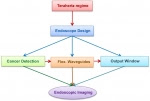P. Doradla and R. H. Giles
http://scholar.harvard.edu/pad/publications/invited-paper-development-terahertz-endoscopic-system-cancer-detection
Terahertz (THz) imaging is emerging as a robust platform for a myriad of applications in the fields of security, health, astronomy and material science. The terahertz regime with wavelengths spanning from microns to millimeters is a potentially safe and noninvasive medical imaging modality for detecting cancers. Endoscopic imaging systems provide high flexibility in examining the interior surfaces of an organ or tissue. Researchers have been working on the development of THz endoscopes with photoconductive antennas, which necessarily operate under high voltage, and require at least two channels to measure the reflected signal from the specimen. This manuscript provides the design and imperative steps involved in the development of a single-channel terahertz endoscopic system. The continuous-wave terahertz imaging system utilizes a single flexible terahertz waveguide channel to transmit and collect the back reflected intrinsic terahertz signal from the sample and is capable of operation in both transmission and reflection modalities. To determine the feasibility of using a terahertz endoscope for cancer detection, the co- and cross-polarized terahertz remittance from human colonic tissue specimens were collected at 584 GHz frequency. The two dimensional terahertz images obtained using polarization specific detection exhibited intrinsic contrast between cancerous and normal regions of fresh colorectal tissue. The level of contrast observed using endoscopic imaging correlates well with the contrast levels observed in the free space ex vivo terahertz reflectance studies of human colonic tissue. The prototype device developed in this study represents a significant step towards clinical endoscopic application of THz technology for in vivo colon cancer screening.



No comments:
Post a Comment